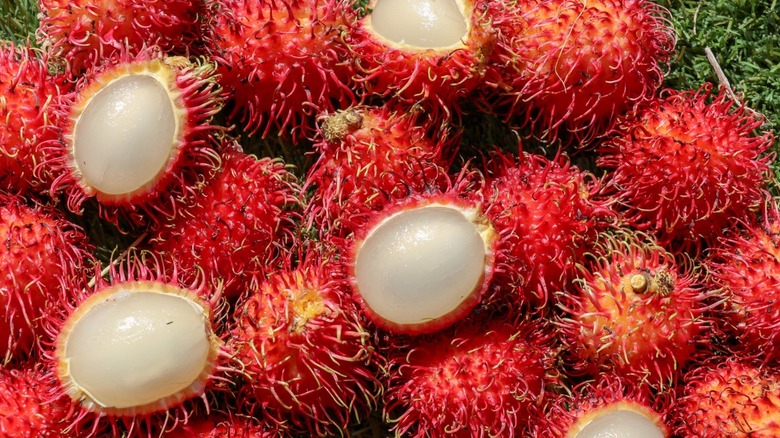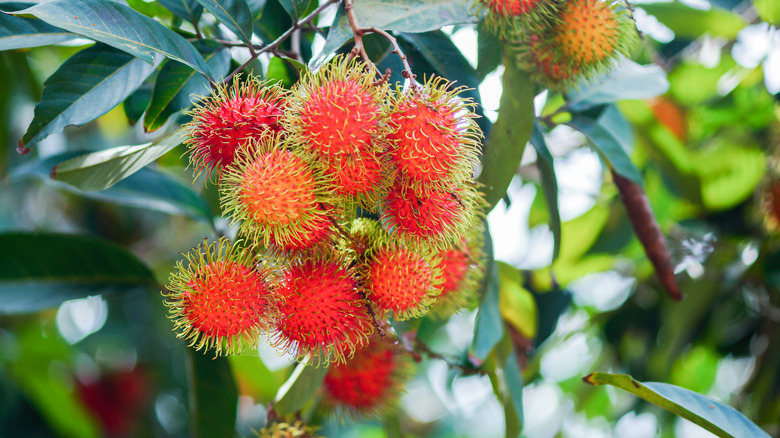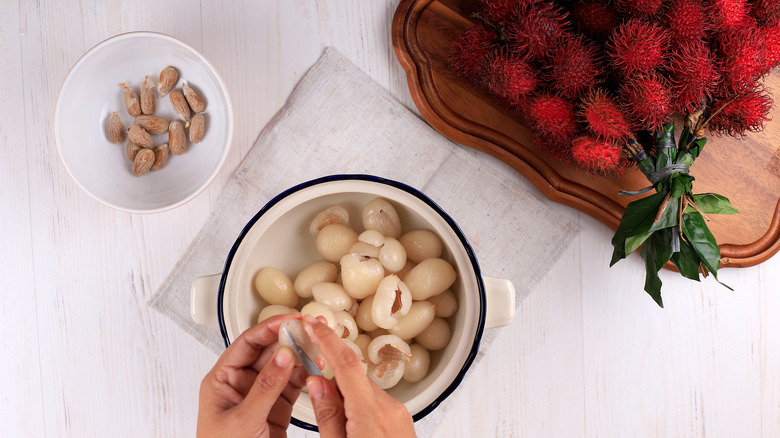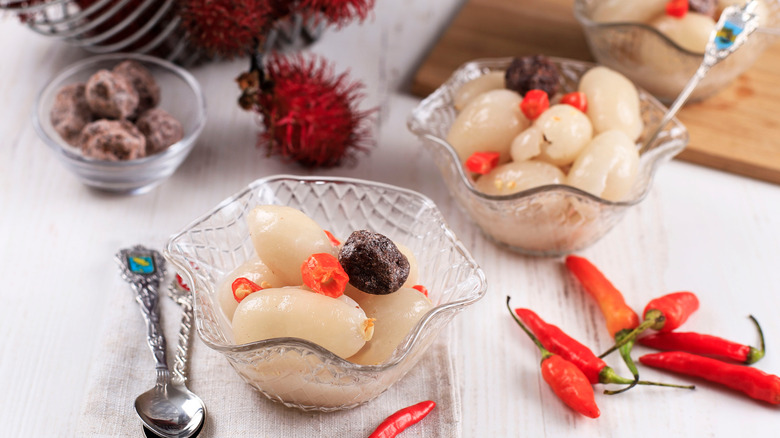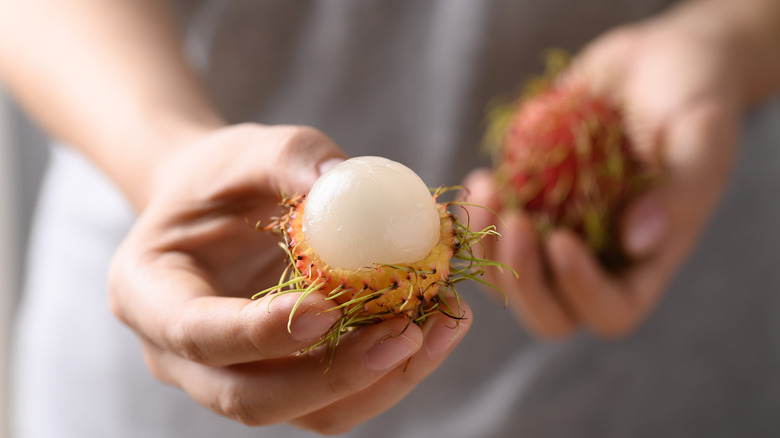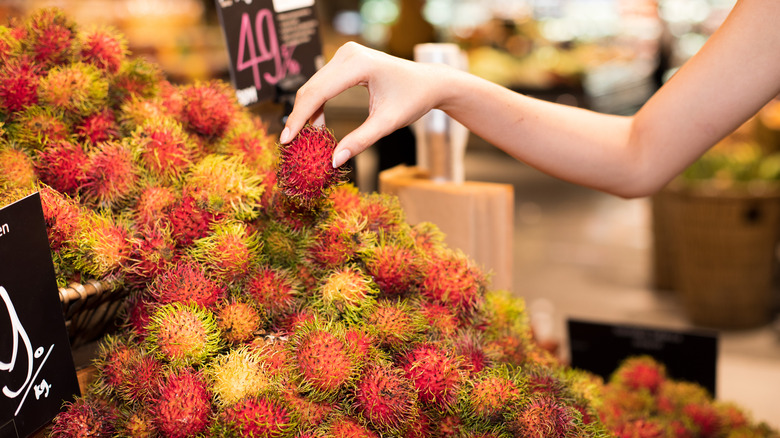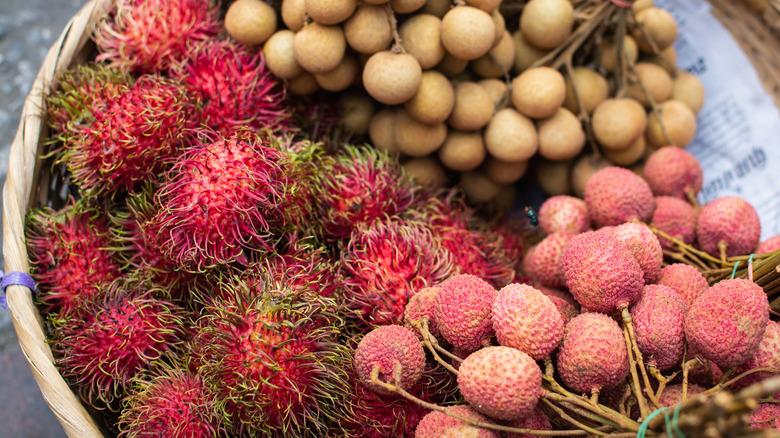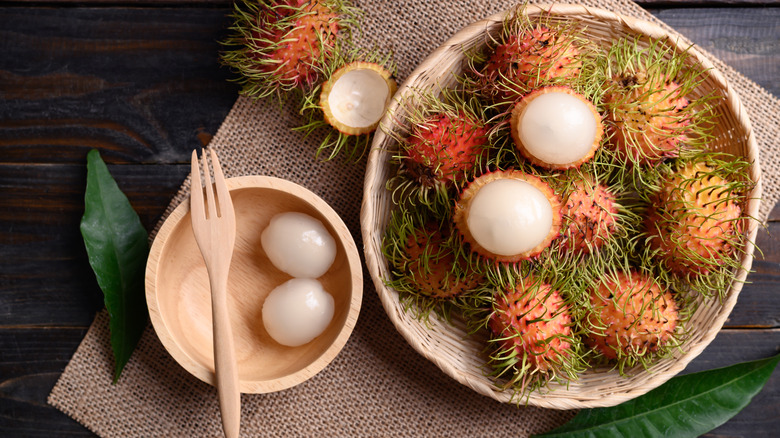What Is Rambutan And What Does It Taste Like?
The rambutan may not be highly recognizable to U.S. produce shoppers, but it is a common tropical fruit in Southeast Asian countries, per Purdue University. The fruit grows on tall trees — nephelium lappaceum — in warm and tropical climates and belongs to the same family of fruits as lychee and longan fruits. Much like its cousins, rambutan may look slightly odd on the outside, but hidden inside is a juicy edible fruit!
Native to Malaysia, the fruit is usually harvested twice a year throughout the Southeast Asian region. The main harvesting season takes place in June and a secondary one in December, with yields from single mature trees in the Philippines reaching a whopping 200 kilos of rambutans in one season.
Usually, rambutans begin to spoil within three days of harvest, which means they are best eaten freshly plucked. However, modern packaging has found a solution in being able to store rambutans in sealed polyethylene bags with enough humidity to keep the fruit fresh for 12 days. That packing technology, paired with the wonders of express global logistics, is how rambutans are able to appear in markets all across the world, including the United States.
What is rambutan?
Rambutan gets its name from "rambut," the Malay word for hair — an obvious reference to its outward appearance, per Purdue University. The fruit's outer skin has long spikes jutting out of it, and typically has a red-colored skin, although its many varieties produce colors ranging from yellow to pink to purple, as well. Like most fruit, rambutan's size varies. Healthline compares it to a golf ball, while MasterClass says it's closer to "a large kiwi fruit or a small apple."
Although the spikes on the skin may look like sharp splinters, they're actually very soft and fleshy. Inside the skin, rambutans have a white flesh and a single seed inside.
Rambutans tend to grow in clusters on trees — much like grapes and lychees — a couple of months after flowering begins and are usually picked off in bunches. Once the fruit becomes ripe, it is harvested in bunches, mainly in June in Malaysia and between July to October or November in the Philippines. After its harvest season, you'll start seeing the fruit in specialty stores or stores selling Asian produce in the United States.
What does rambutan taste like?
While the spiky skin and the seed may be inedible raw, the white flesh inside the rambutan can be eaten that way, as is the case with most fruits. The Spruce Eats compares its flavor to being a mix of grapes and strawberries in that it's both sweet and a tad acidic, with floral notes at the same time. When overripe and spoilt, rambutans have "a sour fermented" flavor, per Fruit Expert. The pale flesh is soft and juicy and has a texture similar to jelly and lychees.
To get to the fleshy bit, make a small cut on the hairy peel and pop the fleshy bit out of it. Make another cut on the white flesh to get rid of the seed inside, or simply eat around it as you would a peach or nectarine. If you do want to try the seed, avoid eating it raw, as Purdue University states it is "reputedly poisonous" in that state, not to mention "bitter and narcotic." The seed can, however, be cooked in a variety of ways to make it edible.
Because rambutans are juicy, they are best eaten as soon as possible after harvest. Although you could store them in the refrigerator for a week or so, if left for too long, rambutans tend to lose their moisture and become dry.
How can you eat rambutans?
According to Purdue University, rambutans are usually eaten plain. In Malaysia, rambutans are often peeled and then boiled till the flesh and seed separate from each other. Although the seeds are speculated to be poisonous, they are further boiled and then mixed with the fleshy part of the rambutan along with sugar, and cloves to make a preserve. A Filipino preparation of the seeds sees them simply roasted before eating, although Healthline notes that "clear guidelines on how to best roast [rambutan seeds] to make it safe for human consumption are unavailable."
You could eat your rambutan raw, of course, but the tropical fruit also makes excellent smoothies, salads, jams, ice creams, and even martinis. Fine Cooking also suggests adding it to savory curries, or pairing the juicy fruit with chilies, as rambutan's fruity and acidic flavor can balance the heat of spicy food.
Feast says the subtle flavor of rambutan fares well alongside fruits like pineapple and passionfruit that have a strong flavor or with the likes of kiwis and pears that will help bring out rambutan's sweetness. Or, use it alongside fresh herbs and citrus fruits — think rambutan mojitos and martinis instead of lychee ones.
Is rambutan nutritious?
Per Healthline, rambutan has several health benefits and is packed with vitamins and minerals. Rambutans have the same amount of fiber as certain types of apples, oranges, and pears, with 1.3 to two grams of fiber packed in a 100-gram serving (about four rambutans). In addition to being an excellent source of fiber, rambutans are a good source of vitamin C. As few as five to six rambutans amount to 50% of your daily recommended vitamin C intake, as well as 20% of the recommended copper intake.
Its vitamin and mineral composition also makes rambutan a good snack to eat, as the high fiber content helps to satiate hunger for longer. A 100-gram serving of the fruit only has 75 calories, so it's also a good fruit to snack on if you're trying to lose weight. Rambutan's high vitamin C content also means it can boost your immune system and help fight any infections.
The site does warn that the spiky skin of the fruit has been found to be toxic to animals "when eaten regularly and in very large amounts." The seeds too have been linked to excessive drowsiness and in extreme cases, leading to death. Although more human studies are required, it's for the best to stick to the nutrition-packed fleshy bit of the rambutan and toss everything else.
Tips for buying rambutans
Because rambutans are mostly grown in Southeast Asia, they travel quite far to reach grocery stores in the United States. The long travel can often bruise or spoil rambutans. So how does a produce shopper tell a good rambutan from a bad one?
Per Fine Cooking, you want rambutans that are as freshly plucked as possible. A telltale sign of a fresh rambutan is its red, orange, or yellow skin, depending on the variety available. The spiky hair on its skin should be straight with only slight curls at the most. Look for rambutans with green or yellow tips and discard anything with shrunken, browning hair. The fresher the fruit, the healthier it will look.
You should also check the rambutans for any wrinkles on the skin or any cuts, bruises, and signs of damage, notes Fruit Expert. If you're buying peeled rambutans, look for ones that have a bright white-colored flesh instead of a pale yellow. You could also give the fruit a squeeze and a whiff. If it's nice and sweet, pop them in your basket, but anything that smells fermented is best left out. If liquid comes out of the fruit when squeezed, grab a different bunch.
Rambutan vs. Lychee
Rambutan and lychee belong to the same family of Sapindaceae (or soapberry); both are tropical fruits native to Asia. There are both similarities and differences between the two, per MasterClass. Both fruits have a comparatively hard skin shell that's sometimes red in color and gives way to a pale white flesh within. The skin and seed of both the fruits are typically discarded, and their flesh is eaten in a similar way. Healthline also notes that the nutritional profiles of both lychees and rambutans are fairly similar.
The most obvious difference between the rambutan and lychee is rambutan's distinct hairy skin, which lychee does not have. Lychees are also smaller in size than rambutans and have a more crisp flesh than the creamy flesh of rambutan. MasterClass compares the taste of a lychee to that of mangosteen and watermelon whereas rambutan, the site notes, is similar in flavor to dragonfruit.
Besides the subtle differences between lychees and rambutans, both fruits are eaten in a similar way, have similar nutritional value, and perhaps most importantly, taste just as great.
Varieties of rambutan
Because rambutans are grown in several countries across the Southeast Asian region, there are more than 200 varieties of the tropical fruit, with each variety differing in appearance, in flavor, and in color, per Specialty Produce.
According to Purdue University, six varieties of rambutan exist in Indonesia alone. The Lebakbooloos variety has a flesh that is difficult to tear off from the seed and the skin but travels particularly well over a long distance. Then, there's the Seelengkeng, a rare and expensive variety favored in China for its similarities with lychee. Yellow-colored rambutans can also be found in Malaya and Batavia. Purdue notes that there exist certain varieties of the fruit that are so sour, even monkeys won't touch them.
Another variety of sugar or longan rambutan in Vietnam is popular for its crispy texture and sugary sweetness, per Vietnam Online. Java rambutans are preferred in Vietnam for having a flesh that is easily pliable from the seed of the fruit and are larger in size. Another expensive, popular variety, Thai rambutan, is favored for its red-colored skin when the fruit is ripe. While this makes the fruit easier on the eye, it also has a slightly sweet flavor that makes it suitable for people who like fruits that are sweet but not sickly so.
